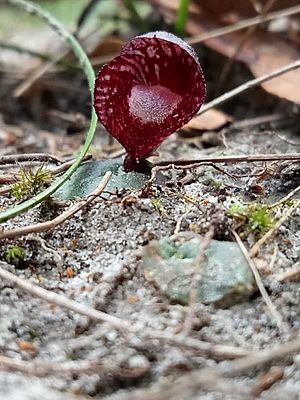Tailed helmet orchid facts for kids
Quick facts for kids Tailed helmet orchid |
|
|---|---|
 |
|
| Corybas undulatus near Sussex Inlet | |
| Scientific classification | |
| Synonyms | |
|
The Corybas undulatus, commonly known as the Tailed Helmet Orchid, is a special type of orchid that grows only in eastern Australia. It gets its name from its unique flower, which looks a bit like a helmet and has a small tail. This orchid has just one leaf and a single, beautiful grey flower with reddish patterns. The flower also has a special part called a labellum, which is covered in tiny bristles and has small teeth along its edges, plus that distinctive little tail at the tip.
Contents
What Does the Tailed Helmet Orchid Look Like?
The Tailed Helmet Orchid is a ground-growing plant that comes back year after year. It's a deciduous herb, meaning it loses its leaves at certain times. Each plant has a single leaf, which is usually about 10–20 mm (0.4–0.8 in) long and 8–18 mm (0.3–0.7 in) wide. The top of the leaf is greyish-green, while the underside can be silvery-green or even reddish.
Each orchid produces one amazing flower that leans backward. This flower is translucent grey with purplish-red and white markings. It measures about 10–13 mm (0.4–0.5 in) long and 9–12 mm (0.4–0.5 in) wide.
Flower Parts
- Dorsal Sepal: This is the top part of the flower, shaped like a spoon or an egg, wider at the top and narrower at the bottom. It's about 12–14 mm (0.5–0.6 in) long and 6–8 mm (0.2–0.3 in) wide.
- Lateral Sepals and Petals: These are very thin, like threads. The lateral sepals are about 3.5 mm (0.1 in) long, and the petals are similar but a bit shorter.
- Labellum: This is the most striking part of the flower. It starts as a tube at its base and for about half its length. Then, it opens up into a wide, heart-shaped dish, about 9–12 mm (0.4–0.5 in) long and wide. The center of this part is whitish and covered with tiny bristles, making it feel rough. The edges of the labellum have tiny teeth, and there's a small, tail-like tip at the very bottom edge.
This orchid usually blooms between May and July.
How the Tailed Helmet Orchid Got Its Name
The Tailed Helmet Orchid was first officially described way back in 1833 by a botanist named Richard Cunningham. He originally called it Corysanthes undulata. Later, in 1942, another botanist named Herman Rupp changed its name to Corybas undulatus.
The second part of its scientific name, undulatus, comes from a Latin word that means "wavy." This likely refers to the wavy edges or appearance of some part of the plant or flower.
Where Does the Tailed Helmet Orchid Grow?
The Tailed Helmet Orchid is not very common, and it's often hard to spot because it's quite small. It grows in forests that have grassy areas and heathlands (areas with low-growing shrubs). You can find it along the coast of Queensland, starting from Bundaberg and going south all the way to Jervis Bay in New South Wales.

